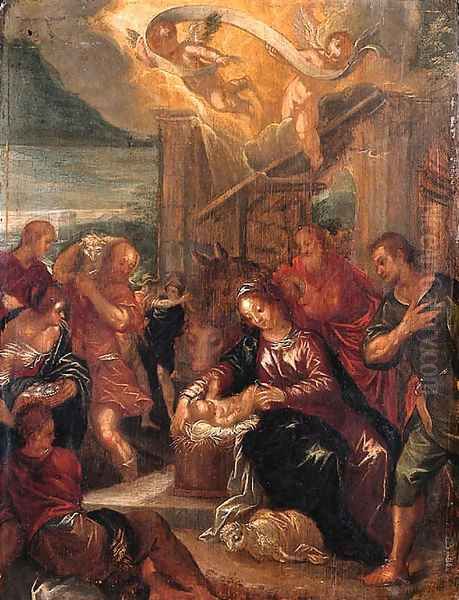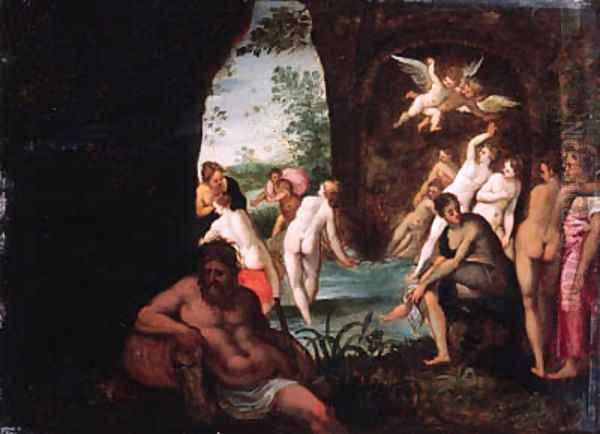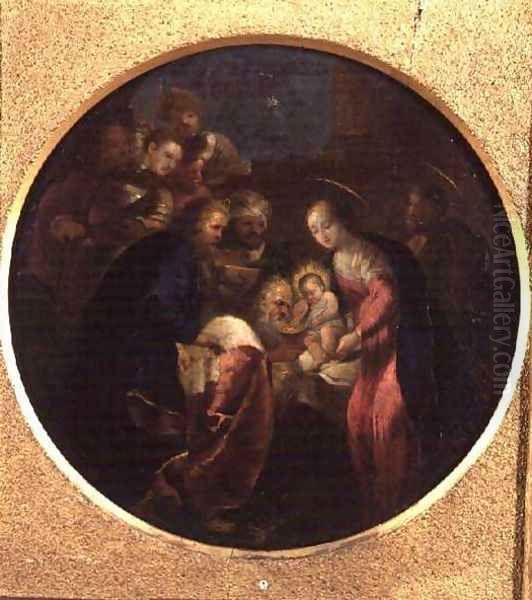Johann Rottenhammer the Elder, a name that resonates with connoisseurs of late Renaissance and early Baroque art, stands as a pivotal figure in the transmission and transformation of artistic styles across Europe at the turn of the 17th century. Born in Munich in 1564 and passing away in Augsburg in 1625, Rottenhammer's career charts a fascinating journey from his native Germany to the vibrant artistic centers of Italy, and back again, leaving an indelible mark on the development of cabinet painting and the fusion of diverse European artistic traditions. His oeuvre, characterized by meticulously crafted small-scale works on copper, primarily explored religious and mythological narratives, earning him considerable acclaim and a lasting legacy.
Early Life and Artistic Formation in Munich
Johann Rottenhammer, often referred to as Hans Rottenhammer, embarked on his artistic journey in his birthplace, the culturally rich city of Munich, the capital of the Duchy of Bavaria. The city, under the Wittelsbach dukes, was a significant center for the arts, fostering an environment where young talents could emerge. Between 1582 and 1588, Rottenhammer received his foundational training under the tutelage of Hans Donauer the Elder. Donauer, himself a respected painter and etcher, likely instilled in his pupil the meticulousness and attention to detail characteristic of the German artistic tradition.
This early training in Munich would have exposed Rottenhammer to the prevailing late Renaissance styles in Germany, which were often a blend of indigenous traditions and influences filtering in from Italy and the Netherlands. While details of Donauer's specific impact are somewhat scarce, it is reasonable to assume that Rottenhammer acquired a solid grounding in drawing, composition, and the techniques of oil painting, preparing him for the transformative experiences that lay ahead. The artistic climate of Munich, with its ducal collections and ongoing projects, would have provided a stimulating backdrop for an aspiring artist.
The Italian Sojourn: A Crucible of Influence

The allure of Italy, the cradle of the Renaissance and a continuing powerhouse of artistic innovation, proved irresistible for many Northern European artists, and Rottenhammer was no exception. Around 1588 or 1589, he embarked on the customary journey south, initially making his way to Rome. The Eternal City, with its ancient ruins and the masterpieces of High Renaissance artists like Raphael and Michelangelo, as well as the more contemporary works of Mannerist painters, would have offered a profound visual education. The provided information notes his study under "Tintoretto and Verrocchio" during this Roman period (1588-1590). While Andrea del Verrocchio was a much earlier Florentine master, the influence of Venetian painters, particularly Jacopo Tintoretto, was indeed significant, though primarily associated with Rottenhammer's subsequent Venetian stay.
It was in Venice, where Rottenhammer resided from approximately 1590/91 to 1595/96, that his artistic identity truly began to crystallize. The Venetian school, with its emphasis on rich color (colorito), dynamic compositions, and sensual rendering of figures and textures, captivated him. He immersed himself in the works of the great Venetian masters, most notably Titian, Paolo Veronese, and Tintoretto. Their grand altarpieces and mythological canvases, filled with dramatic narratives and luminous figures, profoundly shaped his aesthetic sensibilities. Rottenhammer adeptly absorbed these influences, particularly their approach to composition, the depiction of the human form, and the use of vibrant, harmonious color palettes.
During his Venetian period, Rottenhammer began to specialize in small, highly finished cabinet paintings, often executed on copper. This medium, with its smooth, non-absorbent surface, allowed for exquisite detail and a jewel-like luminosity that appealed to collectors. He skillfully translated the grandeur of large-scale Venetian compositions into these intimate formats, creating works that were both sophisticated and accessible.
Collaborations and Artistic Exchange in Venice
Venice at this time was a cosmopolitan hub, attracting artists from across Europe. It was here that Rottenhammer forged important collaborative relationships with several Netherlandish artists, most notably the landscape specialists Paul Bril and Jan Brueghel the Elder. In these partnerships, Bril or Brueghel would typically paint the landscape settings, while Rottenhammer would contribute the figures, often mythological or biblical characters. This division of labor was common and allowed each artist to play to their strengths, resulting in harmonious and highly sought-after compositions.

These collaborations were mutually beneficial. Rottenhammer's elegant and dynamically posed figures animated the meticulously detailed landscapes of his Netherlandish colleagues, while their atmospheric settings provided rich backdrops for his narratives. Works such as The Rest on the Flight into Egypt, where figures by Rottenhammer are set within landscapes by Bril or Brueghel, exemplify this fruitful artistic synergy. He also collaborated with Jan Brueghel the Elder on innovative "garland paintings," where Brueghel would paint elaborate floral wreaths framing a central scene, often religious, painted by Rottenhammer. This practice highlights the vibrant artistic exchange and experimentation occurring in Venice. His interactions extended to other artists as well; for instance, it is believed that Adam Elsheimer, another German painter who later achieved fame in Rome, may have been influenced by Rottenhammer or even worked in his studio for a time in Venice.
Return to Germany and Rise to Prominence
Around 1595 or 1596, Rottenhammer left Venice and returned to Germany, initially to Bavaria. The provided information mentions that he continued his artistic creation under the support of "Bavarian Duke Thomas Rottenhammer." While the specific name of this ducal patron might be a point for further art historical clarification (as the ruling dukes were Wilhelm V and then Maximilian I), it underscores the fact that Rottenhammer found patronage within the Bavarian court circles. His Italian experiences and the refined style he had developed made him a desirable artist for discerning collectors and patrons in his homeland.
A significant commission noted for the year 1600 was for "The Banquet of the Gods," reportedly for Pope Urban VIII. Given that Maffeo Barberini (later Pope Urban VIII) only became Pope in 1623, this commission, if from him, would have been during his time as a cardinal or from another prominent Roman patron. Regardless of the specific patron, The Banquet of the Gods (or Feast of the Gods) was a theme Rottenhammer painted on several occasions, showcasing his skill in depicting complex multi-figure mythological scenes, a genre highly favored by humanist collectors. One such version is famously housed in the Hermitage Museum, St. Petersburg.
By 1606, Rottenhammer had settled in the imperial free city of Augsburg, a major financial and artistic center in Southern Germany. Here, he received city freedom and imperial authorization, signifying his established status. Augsburg provided a fertile ground for his talents. He continued to produce his highly prized cabinet paintings on copper, but also undertook larger-scale commissions, including altarpieces and decorative projects, such as ceiling decorations for churches and residences in Augsburg and Munich. He worked with numerous merchants and noblemen, indicating a broad base of patronage.
Major Commissions and Courtly Appointments

One of the most significant patrons Rottenhammer acquired after his return to Germany was Ernst of Holstein-Schaumburg, Prince-Bishop of Minden. In 1609, Rottenhammer was appointed court painter to Count Ernst and was commissioned to create ambitious works for his residence, Bückeburg Castle. Among these were ceiling frescoes for the "Golden Hall" (Goldener Saal), a lavish state room. These frescoes included allegorical representations, such as the depiction of the Four Elements, demonstrating Rottenhammer's capacity to work on a monumental scale, translating his Venetian-inspired figural style into grand decorative schemes.
His work for Count Ernst represents a high point in his German career, allowing him to showcase his versatility beyond the small-scale cabinet pieces. However, this productive relationship eventually soured. The provided timeline notes that in 1613, Rottenhammer and his patron parted ways, an event that reportedly led to a decline in his creative output. The reasons for this separation are not entirely clear but may have involved financial disagreements or artistic differences, common occurrences in the complex world of artist-patron relationships.
Artistic Style: A Synthesis of North and South
Johann Rottenhammer's artistic style is a compelling synthesis of German precision and Venetian sensuality. From his German heritage, he retained a meticulous attention to detail and a certain linearity in his figures. However, his Italian, particularly Venetian, experience transformed his art. He embraced the Venetian love for rich, luminous color, dynamic compositions often featuring diagonal recessions, and the depiction of idealized, often voluptuous, human figures.
His mythological paintings, such as Venus and Cupid, The Judgment of Paris, or Diana and Actaeon (a version of which is in the Alte Pinakothek, Munich, though the provided text mentions a version in the "Munich New Museum," likely referring to the Bayerische Staatsgemäldesammlungen's broader holdings), are filled with graceful nudes rendered with a smooth, enamel-like finish, particularly in his copper paintings. The flesh tones are warm and pearlescent, set against vibrant draperies and often lush, if sometimes secondary, landscape elements. He was particularly adept at depicting lively, crowded scenes, managing complex groupings of figures with apparent ease.

In his religious works, such as The Adoration of the Shepherds or The Assumption of the Virgin, Rottenhammer combined Venetian compositional grandeur with a Northern European emotional intensity. His figures, while idealized, often convey a palpable sense of devotion or drama. He was a key figure in popularizing these Italianate religious and mythological themes among German collectors, effectively acting as a conduit for artistic trends from south of the Alps. His style can be seen as a Northern interpretation of late Mannerism, transitioning towards the early Baroque, characterized by elegance, sophistication, and a decorative sensibility. He influenced a generation of German artists, and his works were sought after by prominent collectors, including Emperor Rudolf II in Prague, who was a great admirer of small-scale, exquisitely finished paintings. Artists like Hans von Aachen, Bartholomeus Spranger, and Joseph Heintz the Elder, active at Rudolf II's court, explored similar themes and refined aesthetics.
Representative Works: A Closer Look
Several works stand out as representative of Rottenhammer's artistic achievements and stylistic characteristics.
The Feast of the Gods: As mentioned, this was a recurring theme. The version in the Hermitage Museum, St. Petersburg, is a prime example of his skill in handling complex mythological narratives. It depicts an assembly of Olympian deities in a pastoral setting, characterized by its vibrant colors, elegant figures, and a lively, almost festive atmosphere. Such paintings catered to the sophisticated tastes of humanist patrons who appreciated classical mythology.
Death of Adonis: The version of this painting located in the Louvre, Paris, is cited as an early work demonstrating his emulation of Titian. The tragic Ovidian tale of Venus mourning the slain Adonis allowed Rottenhammer to explore themes of love, loss, and beauty, and to showcase his ability in rendering the nude female form and dramatic emotion, all hallmarks of Venetian influence.
Nativity (1608): This work, housed in the Kunsthistorisches Museum, Vienna, exemplifies his religious painting. It likely combines the rich color and dynamic lighting learned in Venice with a tender, devotional quality often found in Northern European art. The intimate scale of many of his religious works on copper made them suitable for private devotion.
The Battle between Centaurs and Lapiths: Also in the Kunsthistorisches Museum, Vienna, this subject provided an opportunity for depicting dynamic action and numerous nude or semi-nude figures in combat, a theme popular since the Renaissance for showcasing anatomical knowledge and compositional skill. Rottenhammer's treatment would have emphasized the swirling energy and drama of the mythological conflict.
The Sinking of Pharaoh's Army in the Red Sea: This biblical scene, a subject he painted on copper, allowed for a dramatic, multi-figure composition filled with turmoil and divine intervention. Such works demonstrated his ability to manage complex narratives within a confined space, achieving a sense of epic scale even in a small format.
These examples, among many others, highlight Rottenhammer's versatility in subject matter and his consistent ability to create visually appealing and intellectually engaging works. His paintings often feature a characteristic sweetness in the facial expressions of his female figures and a graceful, if sometimes mannered, elegance in their poses.
Later Years, Decline, and Untimely End
Despite his earlier successes and international reputation, Johann Rottenhammer's later years were marked by a decline in fortune and productivity. The provided information explicitly states that alcoholism became a significant problem, severely impacting his ability to work and leading to a notable decrease in his output after around 1613, coinciding with the end of his service to Count Ernst of Holstein-Schaumburg. This personal struggle cast a shadow over his final decade.
It is a poignant aspect of his biography that an artist who had achieved such renown and who had been a pioneer in popularizing a new type of cabinet painting in Germany should fall into such difficulties. The art market was competitive, and maintaining a steady stream of patronage was crucial. His declining health and productivity likely made this increasingly difficult. Consequently, Johann Rottenhammer died in Augsburg in 1625, reportedly in poverty. This unfortunate end contrasts sharply with the brilliance of his artistic achievements during his prime. Some sources also mention unfinished works, such as the ceiling paintings for Count Ernst, which might reflect the turmoil of his later career or the ambitious nature of the projects undertaken.
Legacy and Influence
Johann Rottenhammer's legacy is multifaceted. He was instrumental in popularizing small-scale cabinet paintings on copper, a genre that became highly fashionable among collectors throughout Europe in the 17th century. His ability to synthesize Italianate grandeur with Northern precision created a distinct and appealing style. He served as an important bridge between Italian and German art, helping to disseminate Venetian artistic ideals north of the Alps.
His collaborations with artists like Paul Bril and Jan Brueghel the Elder were significant in fostering a cross-cultural artistic dialogue and producing unique hybrid works. He also influenced a number of German artists who followed him, both through his style and his choice of subject matter. Artists like Adam Elsheimer, though developing a highly individual style, shared Rottenhammer's interest in small-format copper paintings and Italianate influences. Even major figures like Peter Paul Rubens, who also spent formative years in Italy, were part of this broader movement of Northern artists absorbing and transforming Italian Renaissance and Baroque principles. Rottenhammer's elegant figures and rich coloring prefigure some aspects of the Rococo in German art, albeit at a much earlier stage.
His works continue to be held in high esteem and are found in major museum collections across the globe. Besides those already mentioned (Louvre, Hermitage, Kunsthistorisches Museum), his paintings are present in the Rijksmuseum in Amsterdam, the Bayerische Staatsgemäldesammlungen (with holdings in Munich and Bayreuth), the British Museum in London (often drawings or prints after his work), and the Gemäldegalerie in Berlin, among others. His paintings also appear on the art market, with auction records reflecting a continued appreciation for his refined and historically significant art, though prices can vary widely depending on the work's quality, condition, and provenance.
Unresolved Questions and Anecdotes
The life of Johann Rottenhammer, like that of many artists of his time, contains elements that remain open to interpretation or further research. The precise nature of his training, the exact circumstances of some of his commissions (such as the "Pope Urban VIII" reference), and the full extent of his workshop practices are areas where art historians continue to piece together information. The anecdote about his landscape abilities being less developed than his figure painting, if accurate, points to the specialization common among artists of the era and perhaps explains the fruitfulness of his collaborations with landscape specialists.
The dramatic downturn in his later life due to alcoholism is a tragic but recurring theme in the biographies of some creative individuals. It serves as a reminder of the personal vulnerabilities that can accompany artistic genius. The contrast between his earlier acclaim and his death in poverty underscores the precariousness of an artist's career in the 17th century, even for one who had achieved considerable fame.
Conclusion: An Enduring Figure in European Art
Johann Rottenhammer the Elder remains a significant figure in the landscape of late 16th and early 17th-century European art. As a German artist who thoroughly absorbed the lessons of the Venetian Renaissance, he forged a distinctive style that appealed to the sophisticated tastes of his era. His mastery of the small-scale cabinet painting on copper set a standard and contributed to the popularity of this genre. Through his religious and mythological scenes, he brought a touch of Italian elegance and dynamism to Northern European art, influencing his contemporaries and subsequent generations. Despite the personal challenges that marked his later years, Rottenhammer's artistic contributions ensure his place as a noteworthy master who skillfully navigated and synthesized the rich artistic currents of his time, leaving behind a body of work that continues to charm and impress. His art serves as a testament to the vibrant cultural exchange that characterized Early Modern Europe, with artists like him acting as crucial conduits for stylistic innovation and thematic exploration.